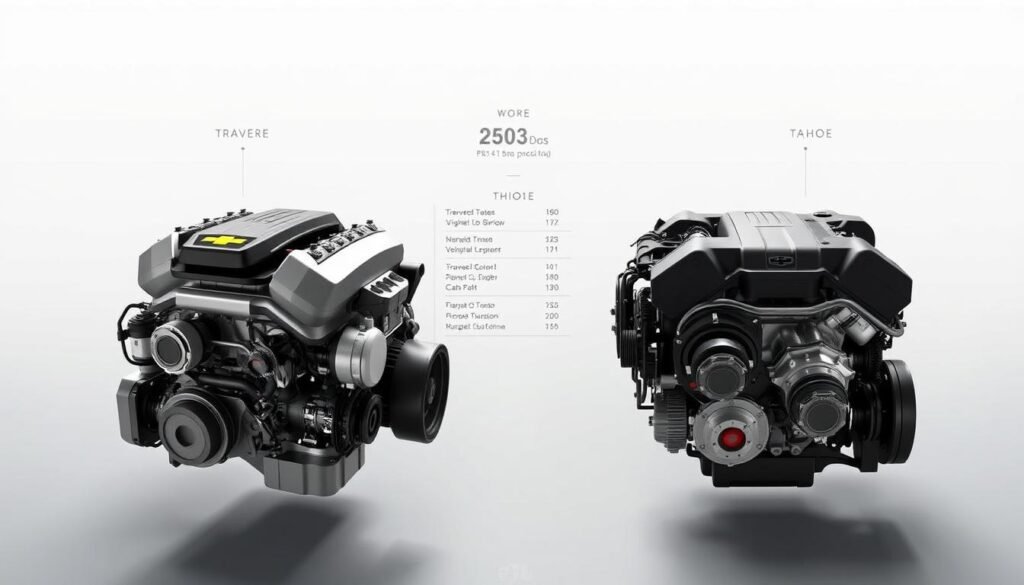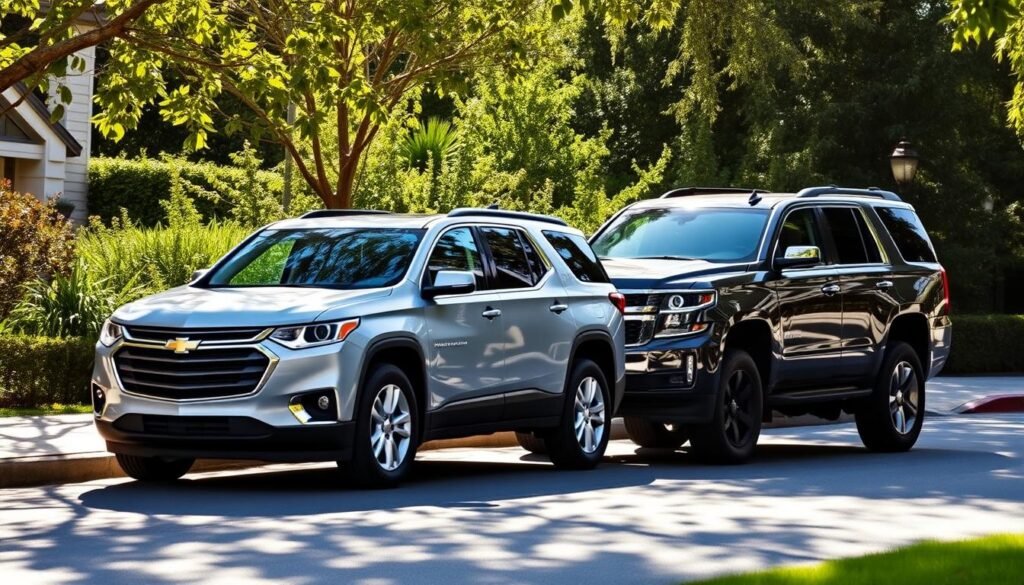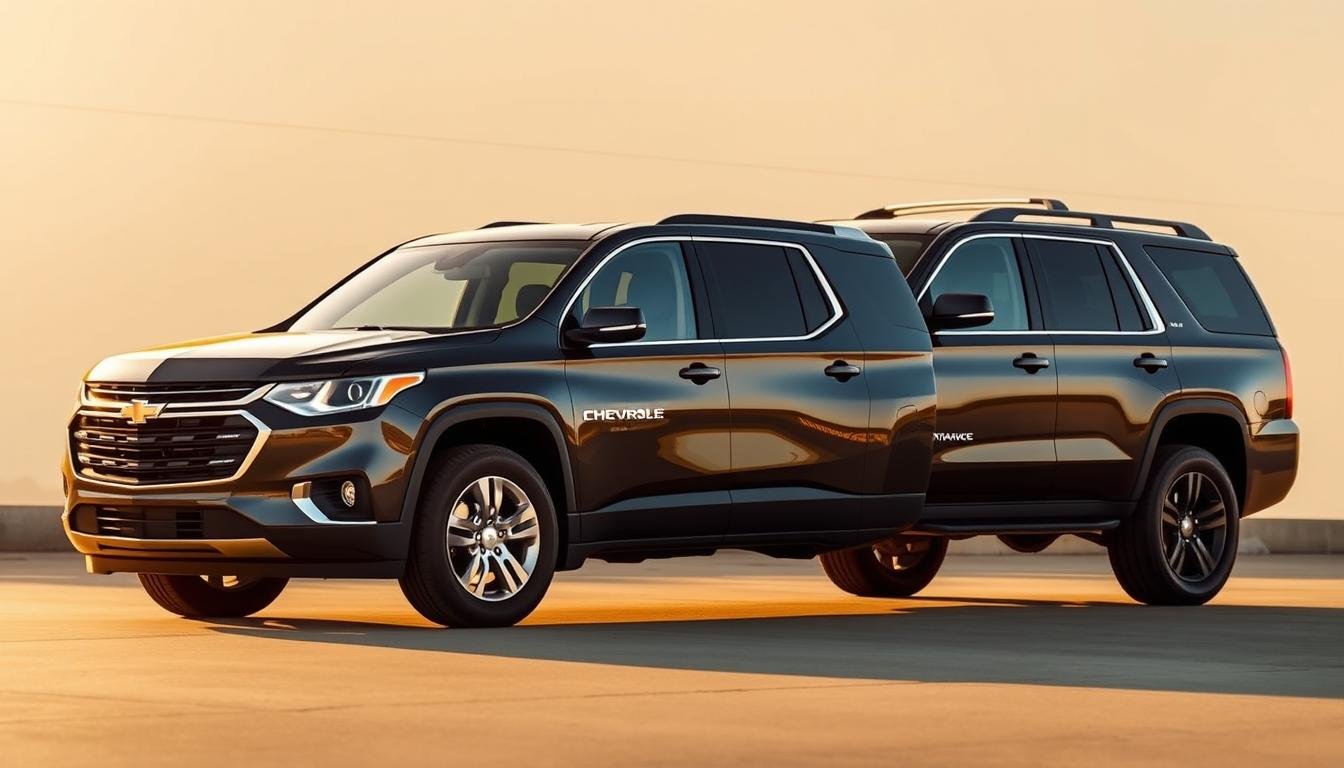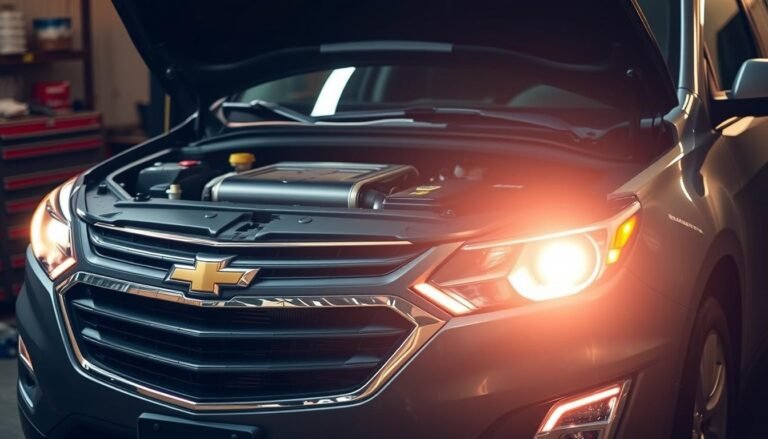Chevy Traverse vs Tahoe Size Comparison
When you look at Chevy Traverse vs Tahoe size, you’re comparing two top Chevy SUVs. The Traverse is a mid-size SUV with three rows.
The Tahoe is a larger, full-size SUV with three rows too. Their size difference affects how much you can load and how comfy they are.
Knowing these differences helps you pick the right one, whether you need space for your family or adventures.
We will cover lots of topics like their sizes and how much room they have inside. You will learn what makes each SUV special. Also, how their size impacts your driving experience.
By the end, you’ll know which SUV fits your life better. Let’s dive into comparing these wonderful vehicles.
Introduction To Chevy SUVs
Chevrolet offers a range of SUVs for different family needs and likes. The Chevy Traverse and Chevy Tahoe are especially notable.
They offer lots of room, power, and the latest tech for a smooth ride. The Chevy Traverse is agile and perfect for families wanting a mix of space and ease of use.
It’s great for everyday driving and fun weekends away. The Chevy Tahoe is for those who need more room and power to tow.
It’s a full-size SUV that performs well for big families or outdoor lovers. Knowing the differences between the Chevy SUVs helps you choose the right one for you.
Whether it’s the Chevy Traverse or the Chevy Tahoe, both provide a ride that meets your needs.
Chevy Traverse Overview
The Chevy Traverse stands out as a family SUV with lots of space and modern tech. It fits up to eight people comfortably with its flexible seating.
Families can feel safer because of its advanced safety options. The Chevrolet Infotainment 3 System lets you stay connected easily.
General Features and Benefits
The Traverse is great for families thanks to its roomy seating. It offers:
- Plenty of storage for gear and personal stuff.
- Cutting-edge safety features to keep drivers alert.
- A user-friendly infotainment system for easy connectivity.
These features make it a top choice for family adventures or daily tasks. It fits well within Chevy’s lineup.
Chevrolet Traverse Dimensions
The Chevrolet Traverse is big, making it great for families. It’s 204.5 inches long, providing a roomy interior.
If you fold the second row, you get up to 97.6 cubic feet for stuff. This makes the Traverse perfect for carrying passengers and their things.
Chevy Tahoe Overview
The Chevy Tahoe is a leading SUV in its class, known for luxury, space, and high performance.
It’s great for big families or those who need more towing power. This SUV has many modern features for comfort and safety.
General Features and Benefits
The Tahoe can seat up to nine people, which is perfect for big families. It comes with safety tech like automatic emergency braking for a safe ride.
With strong performance and a bold look, the Tahoe makes you stand out on the road.
Chevy Tahoe Specifications
| Specification | Details |
|---|---|
| Length | 210.7 inches |
| Cargo Capacity | 122.7 cubic feet (with second row folded) |
| Seating Capacity | Up to 9 passengers |
| Engine Type | V8 (available options) |
| Towing Capacity | Up to 8,400 lbs |
| Fuel Economy | 15 MPG city / 20 MPG highway |
The Tahoe offers lots of room and seating, meeting diverse needs. This places it among the best in large SUVs.
Chevy Traverse vs Tahoe Size
When looking at the Chevy Traverse and Tahoe, they’re different in size. Knowing these differences will help you choose the right one for you.
Comparison of Exterior Dimensions
The Chevy Traverse and Tahoe look different from the outside. The Traverse is 204.5 inches long and the Tahoe is bigger at 210.7 inches.
This makes the Tahoe look bigger on the street. Also, the Tahoe is taller, affecting how comfortable it is inside and what you can see outside.
Interior Space in Chevy Traverse and Tahoe
Inside, the Traverse and Tahoe offer different experiences. The Traverse has more room above your head with 39.9 inches of headroom.
But, the Tahoe has more space for your legs, which is great for tall people. The Tahoe also has about 20% more space for stuff, making it better for carrying big things.

Pricing and Value Comparison
Looking at the prices of the Chevy Traverse and Tahoe shows us their value. The Traverse starts at about $42,095.
It’s a good choice for families wanting space but not wanting to spend too much. The Tahoe starts at $60,995, showing it’s more luxurious with better features.
MSRP and Key Differences
The Tahoe’s higher price points to its extra benefits. Both SUVs are comfy and useful. But the Tahoe has more luxury features and tech options.
A fully loaded Traverse costs around $59,290. This is great for families wanting both room and a good deal.
Cost vs Features Analysis
In our Chevy SUV value study, think about what you get for the price. The Traverse is great for families and easy on the budget.
The Tahoe, though pricier, has better performance and features for those wanting luxury.
Buyers should consider if they want a bargain or are willing to pay more for luxury and top-notch features.
Performance and Powertrains
Looking at the Chevy Traverse and Chevy Tahoe, their performance and engines really stand out. Each one has its own style of power and efficiency to match what you need.
Engine Specifications For Traverse and Tahoe
The Chevy Traverse comes with a turbocharged 2.5L I-4 engine, pushing out a strong 328 hp. It’s a good mix of power and fuel-saving.
The Chevy Tahoe, however, rocks a bigger 6.2L V8 engine with a massive 420 hp. This makes each SUV drive differently.
Fuel Economy Comparison
The Traverse leads in fuel economy, offering 21 MPG combined, ideal for efficiency fans.
The Tahoe gives more power but has lower efficiency at 16 MPG combined. Knowing these numbers helps you pick the right Chevy SUV for you.

Interior Design Features
The inside of an SUV can make it more appealing to buyers. When you look at the Chevy Traverse and Chevy Tahoe, their interiors are not the same.
The Traverse focuses on being useful and cozy, offering comfort and practicality. The Tahoe, on the other hand, feels more luxurious with its high-end materials and finishes.
Quality of Materials
The Chevy Tahoe shines with its fancy Mocha leather interior, making it feel sophisticated. Its finishes are of higher quality and it pays more attention to detail.
The Traverse, while comfy, has materials that are more about daily family use. Both provide plenty of room, but the Tahoe attracts those who want luxury.
Technology Integration
Advanced tech is key in today’s SUVs. The Traverse and Tahoe both have a big 17.7-inch touchscreen and an amazing Bose sound system.
The Tahoe goes a step further with special tech like a bigger heads-up display and better storage.
Knowing about these tech features helps people choose what they want in an SUV.
Seating Capacity and Comfort
When you look at Chevy Traverse and Tahoe, they both fit families and groups well with their three-row setups.
Each car has its own pluses when it comes to how comfortable the back seats are and how much room there is. This makes them great for carrying passengers.
Rear Seats and Cargo Capacity
The Tahoe really stands out because it can fit up to nine people. This is perfect for bigger families or groups who need a lot of seats.
The Tahoe is also a bit more spacious for the legs in the second row, with 42 inches of legroom compared to Traverse’s 41.5 inches.
This extra bit of space makes a big difference for tall people. Looking at cargo space, the Tahoe wins again.
It has a huge maximum cargo area of 122.7 cubic feet with the seats down. The Traverse has less, with 97.6 cubic feet.
This extra room in the Tahoe is crucial for hauling big items or lots of luggage.
Overall Passenger Comfort
But comfort isn’t just about how many people can fit. Both the Traverse and Tahoe have special features for a better ride.
Things like climate control and quality materials stand out. While both cars are comfy, Tahoe’s extra space and perks make it nicer for long trips.
Which car you choose really depends on your needs for seats and space.

Safety and Driver Assistance Features
Safety is key when picking a new SUV, especially for families. The Chevy Traverse and Tahoe have great safety features for you and your passengers.
They have standard safety tech to help keep you safe on the road. This part will look at the safety equipment of both models and the advanced safety tech they offer.
Standard Safety Equipment Comparison
- Automatic Emergency Braking
- Lane-Keeping Assist
- Rear Vision Camera
- Tire Pressure Monitoring System
The Chevy Traverse and Tahoe offer similar safety gear. They’re built to deal with everyday driving risks.
Features like automatic emergency braking and lane-keeping assist show their focus on safety.
Advanced Safety Technologies
- Adaptive Cruise Control (available on Tahoe)
- Surround Vision Camera (exclusive to Tahoe)
- Forward Collision Alert
- Blind Zone Alert
The Tahoe shines with extra driver help features, making it a leader in SUV safety. With adaptive cruise control and a surround vision camera, it gives extra comfort to safety-focused drivers.
These tech options add a level of elegance designed to avoid accidents and boost driving confidence.
Real-World Usage Scenarios
Learn how the Chevy Traverse and Tahoe fit into your life by understanding their uses. The Traverse and Tahoe offer features perfect for busy families.
Find out which SUV is best for weekend trips or city driving to enhance your driving experience.
Family-Friendly Features
The Traverse shines with its big interior and easy-to-use tech, making it great for families. It fits up to eight people comfortably, with space for everyone’s stuff.
Kids stay entertained on long drives thanks to the optional rear-seat entertainment system. The Tahoe, on the other hand, has great safety features and can tow a lot.
It has enough room for all your outdoor gear or the family dog. Driving the Tahoe feels safe because of its size.
Best Uses For Each Model
The Tahoe is perfect for family vacations that need towing, like boats or trailers. With a towing capacity of 8,100 lbs, it’s great for families who love outdoor adventures.
The Traverse is better for city living because of its size. It’s easier to park and move around in tight city spaces. Families that go to city parks or places for fun will like the Traverse.

Resale Value and Reliability
When you’re looking for a car, think about its resale value and how reliable it is. This matters because it affects how good of an investment the car is.
The Chevy Traverse holds its value well over time, which is great if you plan to sell it later. It’s popular and well-priced in the used SUV market.
The Tahoe, while luxurious, loses value faster due to its higher initial price.
Long-Term Ownership Costs
It’s smart to think about the long-term costs of owning a car. The Traverse saves money on gas, which can really add up.
It also tends to have lower maintenance costs compared to bigger SUVs. Don’t forget to think about insurance and how often it needs repairs.
Reliable cars like the Traverse don’t need to be fixed as often, saving you more money compared to luxury cars like the Tahoe.
Comparison of Resale Values
The Chevy Traverse and Tahoe attract different buyers, which affects how much they’re worth later on.
The Traverse keeps its value well because it’s less expensive. But the Tahoe, even with its fancy features, doesn’t always keep its value as high.
Here’s a look at how their resale values compare:
| Model | Initial MSRP | 3-Year Resale Value | 5-Year Resale Value | Notes on Reliability |
|---|---|---|---|---|
| Chevy Traverse | $35,000 | $24,000 (68%) | $18,000 (51%) | Strong reliability ratings contribute to better resale value. |
| Chevy Tahoe | $55,000 | $36,000 (65%) | $25,000 (45%) | Luxury features may not retain value as expected due to high depreciation. |
Conclusion
The Chevy Traverse and Tahoe comparison highlights their unique benefits. The Traverse is great for those needing efficiency and good price.
The Tahoe, however, is top-notch for luxury, power, and space. It suits those wanting a high-end drive.
Picking the right SUV needs thinking about your family size, how you’ll use the car, and what comfort means to you. Knowing these helps you choose the best fit for your life.
So, consider what truly matters to you and your daily needs. This article’s insights, including the chevy traverse vs tahoe rundown, prepare you to choose wisely.
Getting the right SUV brings a fulfilling ride. It’s about finding a vehicle that fits your life perfectly, making every day better.
FAQs
What are the major size differences between the Chevy Traverse and Tahoe?
The Chevy Traverse is 204.5 inches long and offers 97.6 cubic feet for cargo. On the other hand, the Chevy Tahoe is longer, at 210.7 inches, and has a larger cargo space of 122.7 cubic feet. This extra space makes the Tahoe more suitable for big families or if you need more room for your things.
Which SUV is better for families, the Traverse or the Tahoe?
If your family isn’t too big, the Traverse is a good choice with seating for eight. It has plenty of room inside, so everyone is comfy. For larger families, the Tahoe might be better. It seats up to nine and has more room for luggage, along with nicer features.
What kind of performance can I expect from the Traverse compared to the Tahoe?
The Tahoe has a strong 6.2L V8 engine, making it great for towing. It packs 420 hp. But the Traverse, with its 2.5L turbo engine and 328 hp, is easier on gas, offering 21 MPG. The Tahoe gets 16 MPG, so it’s less fuel-efficient.
How do the safety features of the Traverse and Tahoe compare?
Both SUVs come with important safety tech like auto emergency braking and lane help. But the Tahoe takes it up a notch. It adds fancy options like adaptive cruise control and a camera system for all-around views, thanks to its higher price.
Are there any notable interior differences between the Traverse and Tahoe?
Yes. The Tahoe boasts luxury with Mocha leather and fancy details. The Traverse is more about simple comfort and practical design. Both have cool tech, but the Tahoe offers extra premium options.
What are the price ranges for the Traverse and Tahoe?
The Traverse is more wallet-friendly, starting around ,095. The Tahoe starts higher, at about ,995, because of its luxury touches and size. A fully loaded Traverse can reach nearly ,290, while a top Tahoe can go over ,000.
What should I consider regarding resale value and reliability for both models?
The Traverse keeps its value well, thanks to its lower starting price. The Tahoe, while luxurious, may lose value faster. But the Traverse has the upper hand in fuel efficiency, which could save you money in the long run.







